Industry Outlook: Compact Track Loaders
Flotation and attachments gain interest on job sites.
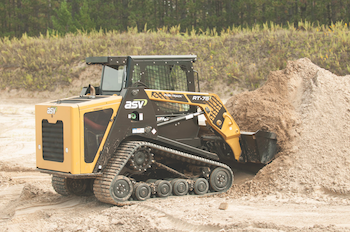 |
| Larger compact track loaders must meet Tier 4 Final regulations, which increases ownership and rental costs. Conversely, they may be able to work more efficiently on job sites. |
Compact track loaders provide rental customers with a viable way to keep working in poor underfoot conditions and their increasing hydraulic power
allow them to carry more powered attachments for a wide variety of jobs. We asked compact track loader experts about their insights into the direction compact track loaders are taking in the market.
 |
| Bill Wake, ASV LLC Director of Product Development |
Tier 4 Final rules challenge compact track loader size
With the move to incorporating Tier 4 Final-compliant engines in compact track loaders, manufacturers are trending toward building compact track loaders that are larger than what users want.
The greater complexity of Tier 4 Final-compliant engines require more space, which can lead to overpowered and more expensive compact track loaders than what rental centers and end users are willing to buy. The aftertreatment systems on Tier 4 final-compliant engines require more electronics, which can make the compact track loaders more difficult to service and repair.
We are seeing next-generation compact track loaders offering better access to equipment components. On the new ASV VT70 compact track loader, mechanics will find swing-away components that allow easy access to service points.
Rental centers are preferring smaller compact track loaders that can be easily transported by a half-ton truck. Although stand-up compact track loaders offer this capability, some operators don’t want to use these types of units because they provide less operator protection. A sit-down compact track loader offers a ROPS system and a hip bar that helps protect the operator.
Users and rental centers are increasingly interested in auxiliary-powered attachments. Mulching heads and other powered attachments expand the versatility of compact track loaders. However, not all auxiliary tools need high hydraulic flow, and that’s why ASV units offer adjustable hydraulic flow to best balance power with the attachment’s needs. This helps the unit work more efficiently, which benefits the end user and the rental center by reducing operating costs.
ASV continues to refine its compact track loader design by incorporating new hydraulic and undercarriage drive systems that are more efficient. These new components allow ASV to develop 75 horsepower compact track loaders that have the power and capabilities of a 90-horsepower unit. The ASV all-rubber track and internal-drive system allow the compact track loader to use its extra power to power hydraulically driven components. In general, we are seeing a 20 percent efficiency gain in our new models with Tier 4 Final-compliant engines.
Like a 2WD versus a 4WD pickup, cost drives the buying decision. If the price was the same, the decision would be easy. When compared with skid-steer loaders, compact track loaders have more complex components, so they cost more to build, own and operate. However, compact track loaders can work in conditions where skid-steer loaders can’t. A compact track loader can help end users work more days in more places.
As qualified workers are getting harder to find, renters are showing increasing interest in enclosed cabs, radios and air conditioning. These options help attract and keep workers.
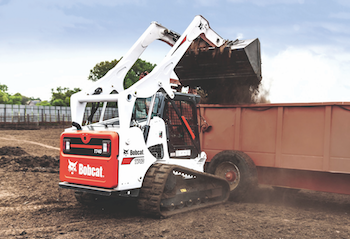 |
| When compared with skid-steer loaders, compact track loaders have more complex components, so they cost more to build, own and operate. However, compact track loaders can work in conditions where skid-steer loaders can’t. |
Rental shift toward compact track loaders
Jason Archbold, Marketing Manager, Bobcat Company
We’ve seen a continuous shift in the rental market toward compact track loaders in recent years. For example, compact track loader sales in rental have increased by double digits, comparing year-over-year sales. We expect compact track loader sales to increase as the economy continues growing and the housing market stays strong, meaning companies will look to rent to supplement their existing equipment.
Industry data shows us the most popular size of compact track loader continues to be 2,000- to 3,200-pound rated operating capacity machines with 74 horsepower diesel engines like the Bobcat T740 compact track loader. Rental stores and renters can stay under the 75 horsepower threshold to avoid engine aftertreatment systems and diesel exhaust fluid. These machines have proven to be top performers while retaining a compact size and weight for easy operation and transportation.
Rental centers continue to update their compact equipment fleets with compact track loaders because the machines may be operated in ground conditions were skid-steer loaders might struggle, such as soft or wet soil. This is a direct reflection of rental store customers wanting to to maintain their schedules and stay productive. With a tight labor market and strict deadlines, going without a machine or not being able to work because of soft soil can be critical, which is why we think compact track loaders will continue to increase in this industry.
Generally speaking, we think rental stores are embracing this shift toward compact track loaders for several reasons. Compact track loaders typically demand a higher rental rate and are rented as long or longer than skid-steer loaders. Once renters get these machines on their job sites and see first-hand the performance, they’re more likely to request another compact track loader when they rent again. In addition, if the renter is working in dirt, sand or on established surfaces like grass, compact track loaders are a smart choice because the tracked undercarriage performs very well in these conditions.
Compact track loaders are regularly paired with other compact equipment, such as compact excavators, to perform work that was previously done with less efficient, larger equipment or work done by laborers with hand tools and wheelbarrows. Rental stores can rent a compact track loader with an excavator to a customer working at a job site and the two tracked machines can accomplish more work in the same amount of time or less.
An example of where we see a concentrated use of compact track loaders is site preparation, land clearing and land maintenance. Customers may rent a compact track loader with a variety of land-clearing attachments – forestry cutter, rotary cutter, stump grinder, flail cutter or chipper – to do work that may previously have been done with larger machines. With some compact track loaders pushing near 100 horsepower and loaded with high-flow auxiliary hydraulics, the loaders have transformed into powerful multi-purpose machines.
We see more companies renting compact track loaders and excavators with attachments for land maintenance, especially in the fall and winter. Companies who were in site prep or land clearing during spring and summer transition to land maintenance to supplement their incomes during months when they may not have otherwise been working.
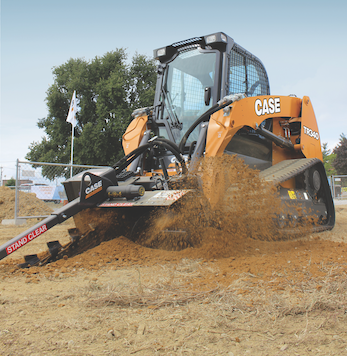 |
| Expanded auxiliary hydraulics options and an electrical connection at the front of the machine provide greater attachment flexibility that makes it capable of a wider variety of jobs and will be rented more often. |
Trend toward larger units
John Dotto, Brand Marketing Manager, Case Construction Equipment
The continued growth of the compact track loader market, and the industry acceptance and demand for compact track loaders makes this product category one that rental centers can embrace knowing that the demand will be there.
Rental centers and end users who are familiar with the operation and upkeep of skid steers will transition to compact track loaders easily. The biggest difference between the two is found in the undercarriage. The tracked undercarriage provides greater flotation and less impact on existing turf. However, that undercarriage also requires a greater initial investment due to the added cost of the tracks and requires an awareness of track maintenance and upkeep. It’s important to keep the tracks clean and minimize counter-rotation.
Rental centers that manage a fleet of compact track loaders need to follow an effective track inspection and documentation process that should be completed pre- and post-rental. The rental contract should include specific track damage language. For example, if the compact track loader operates in an area where sharp coral or rip-rap are common underfoot, your rental contract may include language that prohibits the use of the compact track loader in these types of conditions. Setting expectations with customers regarding track damage responsibility up front, and taking the time to find out the surface conditions your machines will be working on will go a long way to keeping everyone happy and profitable.
Overall, the end-user demand is for bigger machines that offer greater capability. With that often comes higher horsepower and more features, which runs counterintuitive to the rental mantra of simplicity. To answer that need, Case will be rolling out a new product in Q4 2017 with a rated operating capacity much closer to larger-capacity models, but with a 74 horsepower engine. This allows us to keep the Tier 4 Final solution very simple – DOC-only, no fluids to add, no regen, no filters to maintain – while still achieving the greater performance that customers want.
The features that make a compact track loader more valuable to an end user are the same features that make them more valuable to the rental center and will assure the greatest utilization. While the rental market values simplicity, there is also a case to be made for outfitting a portion of each rental fleet with expanded auxiliary hydraulics options and an electrical connection at the front of the machine. These enhancements provide greater attachment flexibility that makes it capable of a wider variety of jobs and will be rented more often. This includes running higher-capacity attachments for any application ranging from snow removal to stump grinding and land clearing.
Rental centers in the snow belt would also be wise to consider ordering compact track loaders with cabs. We are finding that compact track loaders matched with blowers and brooms are a popular rental item for snow-removal contractors.
 |
| Chris Thompson, Ditch Witch Product Manager, Charles Machine Works Co. |
Compact track loaders suited for landscape work
On most landscape jobs, rental operators need to get on and off their machine multiple times throughout the day. The ease of simply hopping on and off the operator’s platform of a compact track loader is much easier than climbing in and out of the cab of a larger machine. The compact machines can also fit through standard yard gates and make it possible to maneuver in small, residential spaces.
The construction industry continues to see a shortage of skilled operators. Contractors and other rental equipment operators are challenged to do more with less, and they need reliable equipment that gets the job done faster and easier. Operators are expecting greater versatility with equipment to save time and money for jobs that might have required multiple pieces of equipment in the past.
Compact track loaders can be outfitted with a variety of attachments to perform multiple jobs, including a trencher, bucket, pallet fork, plow attachments and more. For example, the new Ditch Witch SK1050 compact track loader directs maximum hydraulic power to the attachment, providing operators the power to tackle challenging tasks with more efficient and productive use of hydraulic-powered attachments.
Walk-behind compact track loaders have a low initial cost and a low total cost of ownership, which appeals to rental stores. The durability and ease of maintenance make servicing the machines easier on rental stores and operators, and the improved comfort and ease of use is appealing to rental operators.
Ditch Witch engineers continually listen to rental customers and seek to expand the Ditch Witch product line to fill gaps and meet specific customer needs. Ditch Witch compact track loaders and mini skid-steers share a common look and feel and have evolved to include a construction-grade design to improve durability. They feature a best-in-class, large, ergonomic operating station for enhanced comfort and reduced operator fatigue during long jobs.
As a benefit to rental stores, Ditch Witch mini skid-steer units have advanced designs that do not require daily greasing for simplified maintenance. This helps rental stores keep their rental units out of the shop and on the job, improving total cost of ownership. A variety of attachments help rental customers perform different types of work, and in turn, reduce costs by eliminating multiple machines needed on a job. For
example, operators can take one machine on a job and do trenching, then attach a bucket to remove dirt, and then restore the ground with a box-rake attachment.
There are a variety of mini skid-steer sizes on the market, from very compact, such as the Ditch Witch SK600 unit, to larger and more powerful, like the Ditch Witch SK1550 unit. The SK1550 is designed to complete complex landscape and irrigation projects typically suited for traditional skid-steer loaders, including tree handling and sod transfer. Though larger, this unit still provides the key benefits of a compact track loader, including a smaller job site footprint.
 |
| Randy Tinley, Skid-Steer and Compact Track Loader Product Manager, JCB North America |
Smaller units expand versatility
Transportation regulations are a significant consideration for rental centers and end users. The weight of the machine and attachments affect whether it can be towed to and from the rental location, or whether alternative and more costly transportation is necessary.
Smaller rental operations often face the challenge of acquisition and ownership costs to maintain a fleet large enough to compete with the compact track loader availability and versatility on offer with larger rental brands.
However, compact track loaders are becoming lighter, faster and more capable. This allows rental houses to offer increasing versatility and capability so end users can complete a wider range of jobs while maintaining a less complex compact track loader fleet with fewer models.
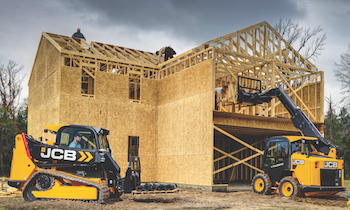 |
| Smaller compact track loader models offer greater versatility on crowded job sites. they can be transported with smaller trucks and trailers, so a CDL driver isn’t needed. |
Advanced electronic controls have been a game changer for renters of compact track loaders. A rental customer can now select a control pattern with which they are familiar, allowing them to quickly adapt to the machine for more efficient operation.
An ever-increasing selection of available attachments, combined with a universal quick hitch, means renters can use the right tool for the job at hand, completing tasks more efficiently and safely.
Increasingly fuel-efficient engines with less complex maintenance programs that do not have DPF and DEF systems are now available. The JCB compact track loader range can make the rental experience less onerous and maximize the time the machine can be applied to the job.
 |
|
Gregg Zupancic, Product Marketing Manager, John Deere Construction and Forestry |
Designing with end users in mind
Maintaining a large fleet is perhaps the biggest challenge that rental centers face today, and with the growth we’re seeing in the compact rental market, larger fleets are becoming more commonplace.
Rental centers want reliable, productive machines to maximize their profits. Time spent repairing a machine is money not being made renting it out to a customer. They also want to have a high resale value on their equipment.
To maximize profits for our rental partners, our goal is to keep machines available for rent 99 percent of the time. We design John Deere products with a focus on durability and spend time fine-tuning the long-life components to maximize machine reliability, especially with machine hydraulics, engines and undercarriages.
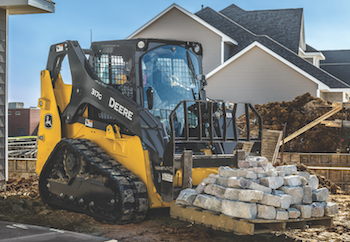 |
| Compact track loaders should be designed with simple operation in mind. Units that allow steering to be switched to match operator preferences are popular with rental customers. |
Rental center owners want machines that are easy to maintain. We designed our machines for superior component accessibility with cabs that roll back for quick access to engine components. On our G-Series machines, all fluid-fill locations are color-coded and the caps are tethered so they can’t fall onto the ground.
We designed the undercarriage of our compact track loaders to be long lasting with hardened-steel rollers and idlers. The radius of the rolling component is very large, which helps the rubber track have a longer life. Metal coverings protect hydraulic lines from shovel damage during cleanup. We also make it easy to tension the rubber track, which is key in sustaining the longevity of the undercarriage. The engine oil change interval on our compact track loaders is 500 hours and 1,000 hours on the hydraulic system, which helps give owners maximum ROI.
More rental centers are seeing the value of telematics and how it plays into their overall ROI. For example, the JDLink machine monitoring system offers anti-theft features and allows the rental center to keep tabs of equipped units at all times.
John Deere engineers are always improving John Deere compact track loaders to be safer to help protect the end user from harm and help rental centers mitigate risk.
Machines are being designed with the entry-level operator in mind. For end users who don’t normally use compact track loaders, they were designed to be very easy to operate, eliminating the risk of creating collateral damage on a job site due to complicated controls. For end users who have experience operating other brands of compact track loaders, Deere units provide a control pattern that allows the operator to control the machine similar to that of another manufacturer with the push of a button. Flexible control choices on our G-Series models allow contractors to choose between electro-hydraulic foot and hand controls or joystick controls that are switchable between ISO- and H-pattern operation.
John Deere provides a line of more than 100 WorkSite Pro attachments to meet all rental segments – from landscape to construction to agricultural material handling that is always expanding to offer more versatility.
 |
|
Jorge De Hoyos, |
Agility adds to popularity
Construction, agriculture and rental markets dominate the top market segments for compact track loaders. The smaller, more agile compact track loaders are used for finishing, grading and sculpturing landscape. In agriculture, medium-sized units, like the vertical-lift Kubota SVL75-2, are multi-purpose machines with applications that include lift and carry, material handling and general farm work.
The rental market favors incidental short- and long-term use of compact track loaders to replace wheel machines in the wet season. The forestry and land-clearing segment has also seen some growth, especially with the larger horsepower models that are often equipped with mulching heads.
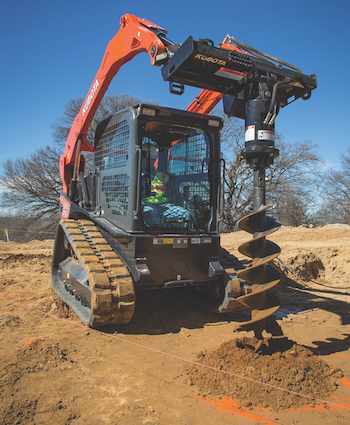 |
| Radial and vertical compact track loaders are more versatile when compared with wheeled skid-steer loaders. |
Manufacturers have been making improvements to undercarriages to extend their life. A welded frame that is integrated into the lower chassis undercarriage found on Kubota compact track loaders offers longer life. New models with higher horsepower and higher lift capacity may displace small dozers and compact wheel loaders in the near future.
 |
| Brian Rabe, Senior Product Manager, Skid and Track Loaders, Manitou Americas |
Track design changes improve dependability
End users can be challenged by compact track loader operation. Detracking can occur doing side-hill work, so choosing a machine that is designed for these types of applications is important. Having an automatic track-tensioning system like the Gehl IdealTrax system makes reinstallation of a track fast and easy with a simple flick of a switch. Standard triple-flange rollers also make a big difference.
Matching the right piece of equipment to the job is important and rental centers may not always have the exact machine capacity, physical size or hydraulic performance required for specific applications. End users and rental center personnel should match application requirements with a track loader’s rated operating capacity to assure safe and efficient operation. In some cases, renting a slightly bigger machine for a little more money can benefit time to completion.
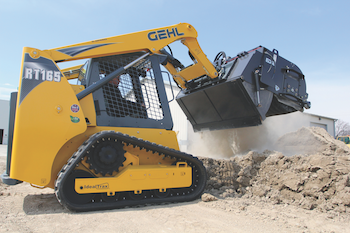 |
| Radial and vertical compact track loaders are more versatile when compared with wheeled skid-steer loaders. |
With track loaders being increasingly used with attachments, it’s important to understand the application and attachment requirements. Renters should work with the rental center to assure the machine has the power and cooling capacity to power the attachment for the planned job.
Track loaders inherently require more inspection, maintenance and adjustment. Many machines are still using very old, high-maintenance technology. Newer models have many innovative features that reduce maintenance time or even eliminate the need for maintenance adjustment.
Keeping the machine clean can significantly improve overall return on investment. It’s easier to keep equipment clean if it has tilt-out foot pods and easy-access belly pans that make it easy to flush out the machine.
Customers require rental units to be 100 percent reliable. The added electrical complexity of Tier 4 engine emissions integration and diagnostic systems added to compact track loaders for regional compliance have led to some customers wanting less. Rock-simple technology, such as mechanical or pilot joystick controls and best-in-class service access are of utmost importance to many customers.
Track loader operators get in and out of the machines frequently, so having easy access and exiting is a huge benefit. Gehl’s IdealAccess door folds up and allows the machine to work with the door open or closed and can be opened with the lift arm in any position. This allows safe, easy entry and egress with large or tall attachments such as pallet forks, mowers and brush cutters. It also allows for better job site communication as the operator can open or close the door without unbuckling the seatbelt.
Attachments extend the versatility of compact track loaders, but just because the attachment fits on the machine doesn’t mean it is going to perform well with it. High-flow equipped machines can be used with a variety of high-flow attachments, and a 14-pin electrical connection and multi-switch joystick can offer the operator better attachment control.
 |
|
Scott Place, Director, National Accounts, |
Radial- and vertical-lift units increasingly popular
We are seeing continued growth in the compact track loader market on both radial and vertical models in the rental segment due to additional versatility when compared with wheeled skid-steer loaders. Contractors want to be able to get on the job early and work through adverse job site conditions, and compact track loaders allow them to do it.
Compact track loaders perform well on slopes and can work in soft, sandy and muddy soil conditions, so they tend to be on rent when skid-steer loaders are typically parked in the rental yard. Combining a compact track loader with an attachment, such as a mulching head, landscape rake, hammer or even a set of pallet forks, will further increase returns.
Understanding the application and job site conditions are key to recommending the right equipment to complete the project on time and on budget.
 |
| Sean O’Halloran, Marketing Manager, Toro |
Compact utility loaders offer an alternative
The rental store owner’s job is getting tougher as rental customers continue to try to do more with less. They are increasingly relying on the rental store to provide a variety of equipment options for unique applications.
In response, equipment manufacturers are striving to deliver more innovative solutions by taking a smarter approach to equipment development. One example is the increase in popularity and functionality of compact track loaders’ kid brother: the compact utility loader.
There are many similarities between compact track loaders and compact utility loaders and manufacturers continue to find ways to enhance the capabilities of both, especially of the compact utility loader.
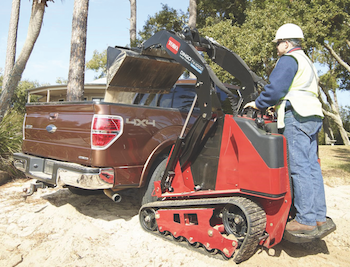 |
| Stand-up track loader units can perform as well as smaller sit-down track loaders, but offer operators easier on/off access to the unit. |
These enhanced capabilities continue to blur the line between them. While a compact utility loader may not be an appropriate choice in every application, they are more nimble and easier to maintain when compared with the bulky and sometimes costly compact track loader.
Operating capacity remains one of the most important aspects of pairing equipment with the application. Many rental store customers
are finding the smaller operating footprint of a compact utility loader is also incredibly useful on the job site. When comparing lift capacity to equipment footprint, compact utility loaders have an edge. A heavy-duty compact utility loader can measure between 34 and 41 inches wide and around 82 inches long, while a compact track loader with a comparable-rated operating capacity may be up to 56 inches wide and 98 inches long. Some compact utility loaders, such as the Toro Dingo TX 1000, has a similar rated operating capacity at nearly half of the weight of some smaller compact track loaders.
Compact utility loaders are nimble machines that can help rental store customers accomplish their tasks out in the field while reducing transportation costs. They also offer improved visibility in tight spaces and increased job site productivity by allowing the operator to get on and off the machine easily to perform other tasks.
Only a few manufacturers offer models in the compact utility loader class that can rival the operating capacities of compact track loaders and skid-steer loaders. One of the primary ways compact utility loaders are increasing rated operating capacity is through integrating vertical lift loader arms, which keep the load closer to the machine, boosting overall operating capacity.
There are many cases where a compact utility loader can deliver the same amount of power found in a compact track loader in a smaller package. This results in lower upfront equipment costs for the rental store and offers renters a streamlined alternative to a compact track loader. With each innovation, rental store owners are increasingly finding that good things often come in small packages.
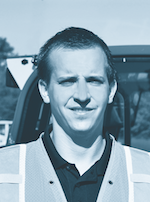 |
| Kevin Scotese, Product Manager, Volvo Construction Equipment |
Transportability affects popularity
One key consideration for the rental house and the end user is transportability. Machines that weigh more than 10,000 pounds require a Commercial Driver License (CDL) to transport.
This is part of the reason why compact excavators and skid-steer loaders are so popular in rental operations. Volvo offers the MCT85C compact track loader and a full line of Volvo skid-steers that are under 10,000 pounds, all of which can be transported without a CDL requirement, in most cases.
Another challenge is assuring the machine does not get vandalized or stolen. To deter vandalism, rental centers and end users often choose a base model with no glass, canopy, and fewer lights. To prevent theft, rental centers can use the geo-fencing feature on the machine’s telematics system.
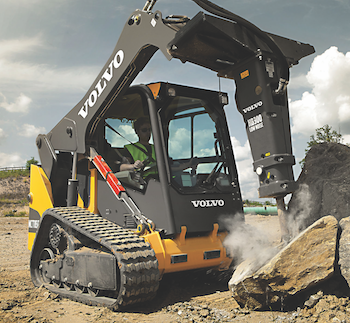 |
| Compact track loaders are trending toward larger sizes. With higher rated operating capacities, larger models allow renters to perform heavier tasks that previously required a compact wheel loader. |
Rental centers can work with customers to geo-fence the machine’s location so the telematics system will send a text message or alert if the unit leaves the specified area. It can also be used to track machine location as well as track machine hours and send alerts if the machine needs service. Keyless starting is a newer optional feature on Volvo compact track loaders and is popular in the rental segment. Keyless starting just requires setting a code for machines and eliminates the need for tracking physical keys.
Compact track loaders are trending toward larger sizes. With higher rated operating capacities, larger models allow renters to perform heavier tasks that previously required a compact wheel loader. These newer and larger models also have greater hydraulic flow to power larger attachments.
An automatic quick-attach option is becoming more popular because it allows users to change attachments without getting out of the cab. This makes a machine more attractive to a renter because it allows operators to be efficient on jobs that require multiple attachments.
The optional control pattern selection feature allows operators to change the operating pattern between the H and ISO pattern from the cab. This is appealing to renters and rental houses because operators may prefer different operating patterns.
Rental houses may also offer track options to work in different terrains, such as wide tracks for flotation, snow tracks to increase the number of seasons the machine can be put to work, and tread patterns for mud, dirt, grass, or gravel. Parallel lift-and-raise is a feature that comes standard on Volvo compact track loaders. This feature is especially appealing for applications requiring forks because it keeps the load parallel to the ground so nothing falls off and the load remains secure throughout the lift cycle.
 |
|
Jay Quatro, Product Application and Training Specialist, Wacker Neuson
|
Tier 4 Final regulations affect cost, rental rates
Today’s modern Tier 4 Final-compliant diesel engines burn much cleaner than older engines, but this comes with added complexity and operators need to be educated on the type of exhaust aftertreatment system a specific rental machine may have.
This can challenge rental centers that may carry several makes and models. Wacker Neuson has addressed this on its new medium-frame track loaders that use a Tier 4 Final-compliant Kohler diesel engine that does not require regeneration or aftertreatment maintenance. They are an ideal choice for rental operations.
In recent years, compact track loaders are available in a wider variety of sizes. Traditionally, compact track loaders have been larger-frame machines for heavy-duty, high-capacity operations. Today, more medium-frame track loader sizes that are more versatile and well suited for rental centers are available. With a smaller overall size and weight, they can be transported with smaller trucks and trailers, often eliminating the need for a special class of driver license.
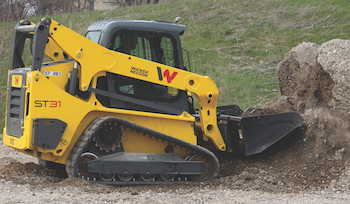 |
| With a universal attachment plate, rental centers can easily swap attachments between machines to match customer needs. |
Today’s compact track loader operator and renter considers operator comfort and control preference in their selection process. The use of electric over hydraulic (EH) controls allows the operator to switch between ISO and H pattern control styles, which are the two most common control patterns. This allows flexibility between customers and eliminates the need to purchase two machines to accommodate each control type. Along with control pattern switching, Wacker Neuson’s medium-frame track loaders also allow control sensitivity to be adjusted to match operator preferences.
Today’s compact track loaders are more than just a machine with a bucket, they are tool carriers. By using a universal attachment plate, a wide variety of attachments can be used. This includes brooms, augers, mowers, snow blowers, asphalt planers and trenchers.
With a universal attachment plate, rental centers can easily swap attachments between machines to match customer needs. Users also benefit from Wacker Neuson’s 30-gallon fuel tank. Operators can run full work days without stopping to refuel, which saves valuable time.
This story originally appeared in the July-August 2017 issue of Pro Contractor Rentals magazine. Copyright 2017 Direct Business Media.









